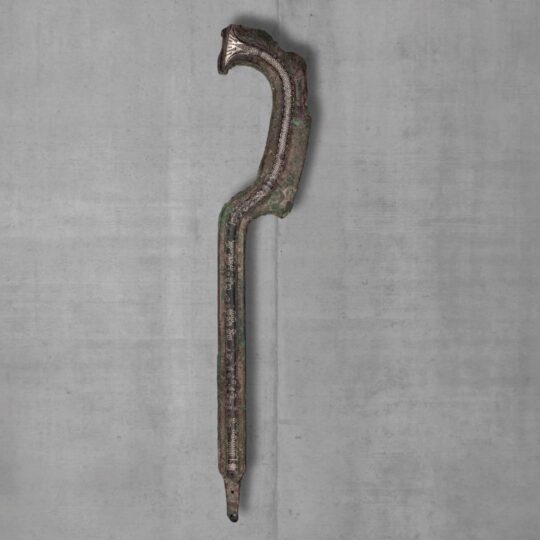20.05.2025
Swingin’ it
 © SMÄK, Foto: R. Hessing
© SMÄK, Foto: R. HessingAlthough its decoration suggests an Egyptian origin, the Munich khopesh-sword was found not in Egypt, but in the ancient city of Sechem in modern-day Palestine. The sword dates to the Middle Bronze Age, around 1750 – 1650 BCE, which in Egypt corresponded to the Middle Kingdom and the Second Intermediate Period. This makes this sword one of the earliest known examples of “black copper” from the Near East.
The bronze khopesh-sword was cast in one piece, with a trench on either side to take an inlaid rib made of dark patinated “black copper”. Observe the exquisite decoration, inlaid with electrum, (a gold-silver alloy) in a process known as damascening. The tip of the weapon is inlaid with electrum foil in the shape of a lotus flower, the blade and ricasso are decorated with double-spirals and geometric flower petals in a trellis pattern. The handle, a separate element that slotted onto the tang, has not survived.
It is unlikely that this weapon saw use in combat: the bronze has a high tin content, the edge is only sharpened on one side, and the decoration is very fine and expensive – all elements pointing to it being a parade or ceremonial weapon. This extremely ornate sword was part of a cache of weapons and tools buried together in ancient Sechem. To get a hint of its original function, we must look further north, to Byblos in modern Lebanon. There, three more khopesh-swords with similar central ribs and decoration were found in three tombs belonging to local rulers. They also date to the Middle Bronze Age, ca. 1830-1730 BCE. Therefore, it seems likely that the Munich sword had originally been the ceremonial weapon of a local ruler.
The weapons from the princely tombs and the Munich ceremonial sword document not only the existence of “black copper” at that period in the Ancient Near East, but also an early mastery of the material and techniques involved. The sword’s extraordinary craftsmanship suggests that the use of “black copper” must have already had a long history in the region. Though the technique is generally estimated to have originated in the Near East, the decoration is clearly Egyptian in style.
Though this type of weapon also came from the Near East, close cultural contacts with Egypt quickly made the khopesh-sword the ceremonial weapon of choice for Egyptian kings during the New Kingdom. For example, the king was often shown wielding a khopesh in scenes of Smiting the Enemy.
This object can be viewed from March 18th to September 14th, 2025 in the exhibition “Corinthium Aes”.
Khopesh-Sword
Sechem, Palestine, ca. 1750-1650 BCE
Bronze, black copper with electrum damascening
SMÄK, Munich, ÄS 2907

